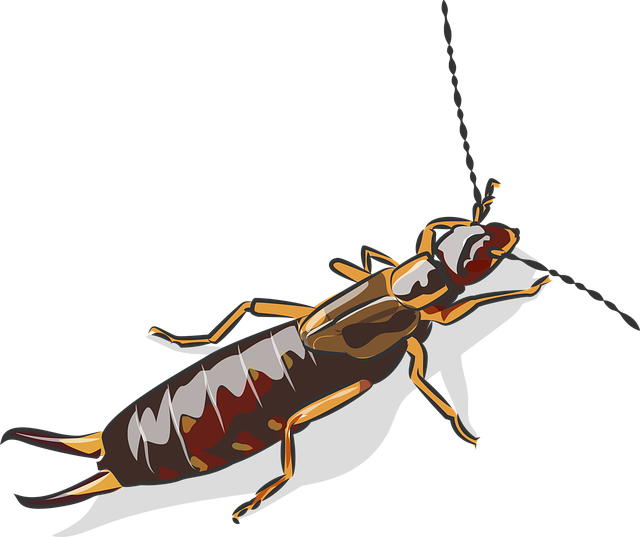Earwigs, attracted to humid environments and dark spaces, enter homes through cracks, reproduce rapidly, and feed on organic matter. For effective earwig pest control, identify their behavior patterns, seal entry points, maintain a dry home, use natural repellents, and employ traps or insecticides to eliminate infestations.
Tired of finding tiny intruders in your home? Earwigs, though unassuming, can become a persistent problem. This guide arms you with knowledge and practical tips for preventing and managing earwig infestations. We delve into their behavior, identify signs of their presence, and offer effective strategies to create an environment that discourages these critters. From understanding their habitat to implementing robust earwig pest control methods, take back your space and say goodbye to these pesky invaders.
Understanding Earwigs: Behavior and Habitat
Earwigs are small, elongated insects known for their distinctive appearance and behavior. Understanding their habits is crucial in effective earwig pest control. These pests prefer humid environments and often seek shelter in dark, narrow spaces. They are commonly found in areas like bathrooms, kitchens, and basements, where moisture is abundant. Earwigs are primarily active at night, creeping into homes through tiny cracks and gaps around doors, windows, and utility pipes. Their diet consists of organic matter, including plants, fungi, and other insects. While they don’t typically bite humans or spread diseases, their presence can be unsettling. Recognizing their behavior patterns is the first step in preventing and managing earwig infestations. By identifying potential entry points and maintaining a dry, well-ventilated home, you can make your space less appealing to these pests.
Identifying Signs of an Earwig Infestation
Recognizing the signs of an earwig infestation is the first step in effective earwig pest control. Keep an eye out for these telltale clues: unusual, waxy substance on surfaces, often left behind as a trail; small holes in clothing, curtains, or other fabrics; and the presence of live or dead earwigs themselves. These pests are nocturnal and tend to hide in dark, damp places during the day, so inspecting less frequented areas like corners, cracks, and crevices at night can help you determine if there’s an infestation.
If you suspect an earwig invasion, act quickly. Earwigs reproduce rapidly, so even a small population can quickly turn into a significant problem. Regular cleaning and sealing entry points—cracks in walls, gaps around windows and doors—can prevent them from entering your home in the first place, making earwig pest control more manageable.
Preventative Measures: Creating a Hostile Environment
Creating a hostile environment is one of the most effective strategies in earwig pest control. To begin, inspect your home for any gaps or cracks that might serve as entry points. Seal these openings with caulk or weatherstripping to prevent earwigs from finding their way inside. Regularly clean and vacuum your space, paying special attention to corners and crevices where earwigs tend to hide. Additionally, maintain a tidy home by promptly addressing any food spills or debris, as earwigs are attracted to organic matter.
Plants can also play a crucial role in deterring earwigs. Certain plants like mint, basil, lemongrass, and lavender have strong scents that these pests find unpleasant. Place potted versions of these plants around your home’s perimeter, especially near entry points like doors and windows. Alternatively, consider using natural repellents like diatomaceous earth or neem oil, which can be sprayed in strategic areas to create a barrier against earwigs.
Effective Earwig Pest Control Strategies
Earwigs are a common household pest that can quickly infest your home if left unchecked. To combat this, adopting a multi-faceted approach to earwig pest control is essential. One effective strategy involves sealing potential entry points around your house, such as gaps in doors, windows, and vents. Earwigs are notorious for sneaking into homes through the smallest of openings, so caulking these areas with weatherstripping or foam seals can significantly reduce their access.
Regular cleaning and maintenance also play a crucial role in earwig pest control. Vacuuming your home frequently helps to remove any earwig eggs or adults that may have made their way inside. Additionally, keeping your environment tidy, especially in kitchens and bathrooms where earwigs tend to thrive, discourages them from setting up shop. Implementing these strategies alongside the use of earwig traps or insecticides specifically designed for their control can provide a comprehensive solution, ensuring your home remains free from these persistent pests.
Earwigs can be persistent pests, but with a combination of understanding their behavior and implementing preventative measures, you can create a hostile environment that keeps them at bay. By identifying signs early and employing effective earwig pest control strategies, such as sealing entry points, maintaining cleanliness, and using natural repellents, you can enjoy a home free from these creepy crawlers. Remember, a proactive approach is key to preventing any insect infestation, including earwigs.
